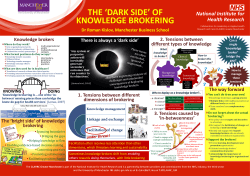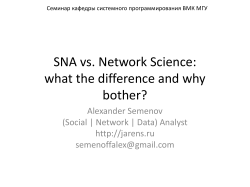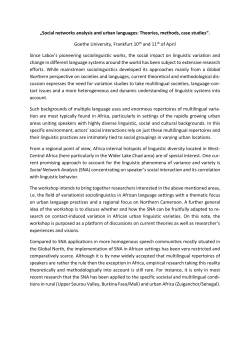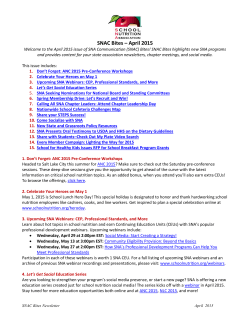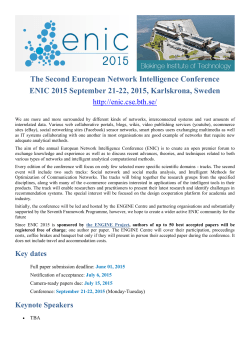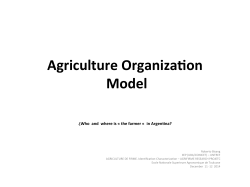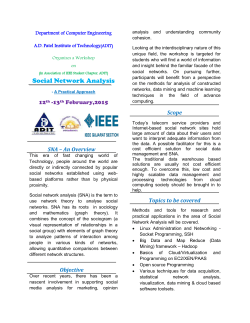
Building a Knowledge Brokering System using social network analysis
Expert Systems with Applications 38 (2011) 14633–14649
Contents lists available at ScienceDirect
Expert Systems with Applications
journal homepage: www.elsevier.com/locate/eswa
Building a Knowledge Brokering System using social network analysis: A case
study of the Korean financial industry
Sungjin Kim a,⇑, Euiho Suh a,1, Youngjoon Jun b,2
a
b
Industrial & Management Engineering, Pohang University of Science & Technology, South Korea
Information System Analysis Team, Korea Financial Telecommunications & Clearings Institute, South Korea
a r t i c l e
i n f o
Keywords:
Knowledge management
Knowledge transfer
Knowledge Brokering System
Social network analysis
a b s t r a c t
The importance of knowledge is increasing in our global and knowledge-based society. As a part of
knowledge management, successful knowledge transfer can improve an organization’s competitive
advantages and increase an organization’s valuable knowledge assets. However, knowledge transfer is
complex and a lot of factors exist that affect successful knowledge transfer such as context, social networks, and IT/IS. This paper aims at the role of the knowledge broker which is to be a link between knowledge seekers and knowledge experts. In this context, this research implemented a Knowledge Brokering
System – called K-broker system – as a prototype system to improve knowledge transfer in an organization based on an analysis of users’ social network. The K-broker system can provide a ‘single view’ screen
for identifying knowledge experts and has no bottlenecks in contrast with a human knowledge broker
and can provide a permanent communication channel between knowledge seekers and knowledge
experts.
Ó 2011 Elsevier Ltd. All rights reserved.
1. Introduction
The famous phrase ‘Knowledge is Power’ stated originally by
Francis Bacon, could be interpreted to means that knowledge based
firms can gain a competitive advantage in a globally competing and
knowledge-based society. Many examples of knowledge management literature have emphasized that knowledge is the foundation
of innovation (Davenport & Prusak, 1998;Drucker, 1993) and has
become an important organizational resource of firms (Alavi &
Leidner, 2001). Also knowledge resources are critical for the successful development and maintenance of a competitive advantage
by creating value for the firm’s stakeholders (Carlile & Rebentisch,
2003; Khamseh & Jolly, 2008). Knowledge is certainly one of the
best resources and is the only sustainable competitive advantage
(Khamseh & Jolly, 2008).
⇑ Corresponding author. Address: POSMIT Lab, Industrial & Management Engineering Building, Pohang University of Science & Technology, 790-784 San 31,
Hyoja-dong, Nam-gu, Pohang, Kyungbuk, South Korea. Tel.: +82 54 279 5920; fax:
+82 54 279 2870.
E-mail addresses: sciv@postech.ac.kr (S. Kim), ehsuh@postech.ac.kr (E. Suh),
joon7@kftc.or.kr (Y. Jun).
1
Address: POSMIT Lab, Industrial & Management Engineering Building, Pohang
University of Science & Technology, 790-784 San 31, Hyoja-dong, Nam-gu, Pohang,
Kyungbuk, South Korea. Tel.: +82 54 279 5920; fax: +82 54 279 2870.
2
Address: 717 Yoksam-dong, Kangnam-gu, Seoul 135-758, South Korea. Tel.: +82 2
531 1463; fax: +82 2 531 1407.
0957-4174/$ - see front matter Ó 2011 Elsevier Ltd. All rights reserved.
doi:10.1016/j.eswa.2011.05.019
Knowledge management (KM) is a strategy for creating, accessing and supporting knowledge resources (Agrawal & Henderson,
2002), and consists of four sets of ‘knowledge processes’: (1) creation, (2) storage/retrieval, (3) transfer, and (4) application (Alavi &
Leidner, 2001). As an important and essential part of knowledge
management, successful knowledge transfer can improve an
organization’s competitive advantages and increase the value of
an organization’s knowledge assets (Argote & Ingram, 2000;
Cranefield & Yoong, 2007). Therefore, we should focus on
successful knowledge transfer and especially tacit knowledge as
it is more complicated and difficult to transfer in organizations.
There have been various definitions of the knowledge transfer
suggested by researchers. Knowledge transfer in organizations is
the process in which one unit (e.g., group, department or division)
is affected by the experience of another according to Argote and
Ingram (2000). Major and Cordey-Hayes (2000) saw the transfer
of knowledge as a conveyance of knowledge from one place,
person, ownership, etc., to another. Szulanski (2000) also defined
knowledge transfer as a process in which an organization recreates
and maintains a complex, casually ambiguous set of routines in a
new setting. According to King (2006), knowledge transfer is the
focused, unidirectional communication of knowledge between
individuals, groups or organizations such that the recipient of
knowledge (a) has a cognitive understanding, (b) has the ability
to apply the knowledge, or (c) applies the knowledge. Another definition of knowledge transfer is the process by which knowledge
receivers acquire knowledge from providers so that it could
14634
S. Kim et al. / Expert Systems with Applications 38 (2011) 14633–14649
accumulate and renew a productive capability (Liao & Hu, 2007).
And lastly, Leiter, Day, Harvie, and Shaughnessy (2007) defined
knowledge transfer, as the process of sharing new knowledge
among members in an organization, and explained that it is a process within the broad scope of organizational learning that also includes the codification and retention of existing knowledge and
practices.
In this paper, knowledge transfer can be redefined as a process
that has a direction and intention to retain and recreate the valuable knowledge assets of an individual or organization.
The importance of knowledge has been widely emphasized and
knowledge transfer is also an important area of knowledge management. Knowledge transfer has been said to be the basis for competitive advantages in firms (Argote & Ingram, 2000), and is said to
be an essential source of a firm’s sustainable competitive advantage (Osterloh & Frey, 2000). Transferring knowledge is a key
dimension of a learning organization and learning occurs when
knowledge in one part of an organization is transferred effectively
to other departments and then used to solve problems there or to
provide new and creative insights. So, effective knowledge transfer
is one of the most important knowledge management activities for
organizations (Goh, 2002).
Without successful knowledge transfer, all problem-solving
methods or operational skills have to be reinvented again when
knowledge is needed (King, 2006). If global and multinational corporations do not have successful knowledge transfer from their
parent company, it is difficult for subsidiaries to build up their
knowledge base, improve their capabilities, accelerate management localization, and survive intense competition to generate
good returns for their parents (Wang, Tong, & Koh, 2004). Wakefield (2005) argued that knowledge transfer is crucial for the development of effective KMS (Knowledge Management System).
In spite of the fact that the importance of knowledge transfer
has been emphasized continuously, some difficulties still exist in
successful knowledge transfer. Szulanski (2000) suggested three
factors that negatively affect knowledge transfer processes; the
arduous relationship between source and recipient, stickiness,
and organizational context. An arduous relationship may increase
the efforts needed to resolve transfer-related problems, and recipients must be able to discard old practices and sustain new ones,
and organizational context can affect the willingness and ability
of organizational subunits to complete transfer-related tasks.
Ko, Kirsch, and King (2005) argued that communication-related
factors influence the transfer of knowledge between consultants
and clients both directly and indirectly in information system
implementation processes. Low source credibility inhibits communication and learning and the recipient’s communication decoding
competence influences knowledge transfer.
Argote and Ingram (2000) insisted that the member to member
or social network plays an important role in knowledge transfer.
People play the most critical role in the success of technology
transfer and the social network can link organizational units to
new sources of knowledge and help to interpret new knowledge.
For the development of a successful knowledge transfer, this
paper could make use of the concept of ‘knowledge broker’ (Hargadon, 1998). According to Hargadon, a knowledge broker is an intermediary (an organization or a person), which provides links,
knowledge sources, and in some cases knowledge itself (i.e. technical know-how, market insight, etc.) to an organization in its network. Also a knowledge broker is critical for supporting the
innovative behaviors of individuals within organizations and provides opportunities for individual and organizational capacity
development (Dobbins et al., 2009).
By using the concept of a ‘knowledge broker’, this paper can
provide the framework necessary for the successful transfer of tacit
knowledge. There has been some previous research on the role of a
knowledge broker, but they have limitations and were inadequate
for practical application. An intelligent agent-based knowledge
broker for an enterprise-wide healthcare knowledge procurement
system framework (Hashmi, Abidi, & Cheah, 2002) focused mainly
on explicit knowledge retrieval and procurement and Loew,
Bleimann, and Walsh (2004) suggested that a knowledge broker
network based on communication between humans but with their
framework users may then have too many steps to take to reach
experts. In research by Johri (2008), knowledge brokering involves
a multitude of things and the boundaries are also numerous and
there is a dynamic nature to the process where the needs of the
role and the context in which the role is performed keeps changing,
but the boundary spanning knowledge brokering model failed to
take into account the dynamicity of the role of a knowledge broker.
Boden and Avram (2009) concentrated on the particular roles the
knowledge brokers play in distributed development practices in
the context of two small companies. Because of the small size of
the teams, knowledge brokers could be bottlenecks and be overloaded, and permanently open communication channels are
needed.
In summary, this paper suggests implementing a system (not a
human being) which can link knowledge seekers and experts and
remove the bottlenecks and overloads for the successful contextspecific and tacit knowledge transfer. As a tool to reflect social networks among members in an organization, this paper focuses on
social network analysis.
The objectives of this paper are as follows:
First, the implementation of a Knowledge Brokering System
using social network analysis.
Second, enlarging the competitive advantages of firms by using
effective knowledge transfer with a Knowledge Brokering System.
The rest of this paper is organized as follows. In Section 2, previous research on knowledge transfer is mentioned and a knowledge broker and social network analysis is introduced. In
Section 3, a framework, subsystems and functions of Knowledge
Brokering System that developed this study is described. Implementation of a prototype of Knowledge Brokering System, K-broker and how it works are described in Section 4. Finally, the
concluding remarks and further works are presented in Section 5.
2. Related works
2.1. Tacit knowledge
The concept of ‘tacit knowledge’ was introduced by Polanyi
(1996). He describes tacit knowledge as follows: ‘I shall reconsider
human knowledge by starting from the fact that we can
know more than we can tell’. And Nonaka and Takeuchi (1995)
distinguished between tacit and explicit knowledge (shown in
Table 1).
Tacit knowledge is essentially the opposite of explicit (codified)
knowledge. Explicit knowledge exists in print or in an electronic
form and is available either freely or free of charge after a small
registration fee (Bush, 2008).
The characteristics of tacit knowledge can be classified as
follows:
Table 1
Distinction between tacit and explicit knowledge.
Tacit knowledge
Explicit knowledge
Subjective
Knowledge of experience (body)
Simultaneous knowledge
(here and now)
Analog knowledge (practice)
Objective
Knowledge of rationality (mind)
Sequential knowledge
(there and then)
Digital knowledge (theory)
S. Kim et al. / Expert Systems with Applications 38 (2011) 14633–14649
First, tacit knowledge is difficult to write down and to formalize
(Nonaka, 1991). Tacit knowledge is not easily shared and codified.
Tacit knowledge consists of habits and culture that we do not always recognize in ourselves. In many knowledge management literatures, tacit knowledge refers to knowledge which is only known
by an individual and is difficult to communicate to the rest of an
organization. People who possess tacit knowledge cannot describe
the decision rules that underlie their performance: ‘the aim of a
skillful performance is achieved by the observance of a set of rules
which are not known as such to the person following them’
(Polanyi, 1996).
The second characteristic of tacit knowledge is that it is personal knowledge (Nonaka, 1991; Sternberg, 1994). Sternberg
(1994) and Nonaka (1991) argue that tacit knowledge has a cognitive dimension and consists of mental models that individuals follow in certain situations. Tacit knowledge becomes so embedded
in the individual that it seems entirely natural (Ravetz, 1971).
Yet a characteristic of tacit knowledge is that it is practical
(Sternberg, 1994) and that it describes a process. Tacit knowledge
cannot be easily codified and can only be transmitted via training
or gained through personal experience. Tacit knowledge has been
described as ‘‘know-how’’ (Nonaka, 1991) – as opposed to
‘‘know-what’’ (facts), ‘‘know-why’’ (science), or ‘‘know-who’’ (networking). Nonaka (1991) argues that know-how may be used as a
synonym for tacit knowledge because ‘tacit knowledge consists
partly of technical skills – the kind of informal, hard-to-pin down
skills captured in ‘‘know-how’’’.
The final characteristic of tacit knowledge is that it is context
specific (Nonaka, 1991; Sternberg, 1994). Tacit knowledge ‘is
knowledge typically acquired on the job or in the situation where
it is used’ (Sternberg, 1994), and is ‘deeply rooted in action and in
an individual’s commitment to a specific context – a craft or a profession, a particular technology or product market, or the activities
of a work group or team’ (Nonaka, 1991).
According to the characteristics of tacit knowledge explained
above, tacit knowledge is slow and costly to transmit, but is a crucial source of sustainable competitive advantage because it is difficult for competitors to imitate it (Teece, 1998). Tacit knowledge is
hard to codify so it cannot be transferred easily (Osterloh & Frey,
2000), and if a greater about of knowledge is tacit in an organization the transfer of knowledge can often become less (Khamseh &
Jolly, 2008).
2.2. Knowledge transfer factors
Knowledge transfer occurs in various situations; between individuals, from individuals to explicit sources, from individuals to
groups, between groups, across groups, and from a group to the
organization (Alavi & Leidner, 2001). A lot of research exists on
identifying and verifying the factors that affect knowledge transfer
in various scenarios: knowledge characteristics, individual, organizational, inter-organizational, international and university-industry. Those factors can impact on successful knowledge transfer
and can work as facilitators or barriers (Hall, Sapsed, & Williams,
2000).
From the list of knowledge transfer factors, we should consider
the following three factors as being vital for the successful transfer
of tacit knowledge; context, social networks, and Information
Technology/Information System (IT/IS).
As described in the previous section, tacit knowledge is practical and context-specific (Nonaka, 1991; Sternberg, 1994), therefore
the transfer of tacit knowledge should be also context-specific.
Knowledge can be embedded in almost everywhere such as people,
tools, routines, products, and systems (Argote & Ingram, 2000;
Cummings & Teng, 2003).
14635
Knowledge context, organizational context, relational context
and social context can influence the process of knowledge transfer
(Cummings & Teng, 2003; Riusala & Suutari, 2004) and it is necessary to be aware of the context factors for the successful management of knowledge transfer (Kasper & Muhlbacher, 2008). Also
Hutzschenreuter and Listner (2007) described the reasons for the
failure of knowledge transfer projects and gave attention to knowledge transfer context factors like ‘sender- and receiver-related contextual factors’ and ‘knowledge-related contextual factors’ for
successful knowledge transfer. Lin, Geng, and Whinston (2005) addressed five factors that constitute the basis of the expectations
that the sender and the receiver has for the value of the knowledge
transfer in their ‘Sender–receiver’ framework. One of the factors is
the context in which the knowledge is put to use. According to
Yakhlef (2007), knowledge transfer does not only take place within
a social context, but that context itself is part of the content of
knowledge.
The second factor is social networks. As people play the most
critical role in the success of technology transfer, the social network also plays an important role in knowledge transfer and can
link organizational units to new sources of knowledge and aid
the interpretation of the new knowledge (Argote & Ingram,
2000). In their research on the impact of network structures on
knowledge transfer, Fritsch and Kauffeld-Monz (2008) found
strong ties to be particularly important with regards to the exchange of knowledge and information and it is important to learn
more about the ways in which knowledge and information in networks is transferred between the actors and how the strong ties
are formed.
Also, Tang, Mu, and MacLachlan (2008) proposed that the
knowledge transfer speed and the empowerment of individuals
play dominant roles in the process of knowledge transfer. The
higher the knowledge transfer speed and the more powerful the
influence of the individuals who own new knowledge, the quicker
other members in the network will absorb the new knowledge.
To enhance knowledge transfer in multinational corporations,
social interaction is a key mechanism for leveraging the knowledge
because it enables the development of cognitive and relational
dimensions of social capital (Gooderham, 2007). Plentiful ways of
social interaction are especially important for the transfer of tacit
knowledge.
Formal knowledge transfer methods, such as instructor-led
training and computer-based training, can be used to pass on preliminary job task knowledge, and informal knowledge transfer via
the social network of employees can be used to transfer more of
the detailed job task and role knowledge (Lahti, Darr, & Krebs,
2002).
The third factor to be considered for the successful transfer of
tacit knowledge is Information Technology/Information System
(IT/IS). IT/IS can increase knowledge transfer by extending the individual’s reach beyond formal communication lines (Karlsen &
Gottschalk, 2004), and IT/IS can be used as a means to catalog
individuals in the organization that hold critical tacit knowledge,
and then enable communication between those who need the
knowledge and those who have it (Bloodgood & Salisbury, 2001;
Syed-Ikhsan & Rowland, 2004).
IT/IS can enhance the transfer of tacit knowledge (Changchit,
2003) and can increase the sharing of information and information
about sources of knowledge, as well as knowledge about sources of
information, and the development of technologies that can provide
the information richness of face-to-face contact will remove colocation as a requirement for the effective transfer of tacit knowledge, thereby increasing the efficiency and flexibility of knowledge
transfer (Roberts, 2000).
IT/IS can improve the efficiency of knowledge transfer by
increasing the speed of communication and decreasing costs due
14636
S. Kim et al. / Expert Systems with Applications 38 (2011) 14633–14649
to time and distance (Albino, Garavelli, & Gorgoglione, 2004).
Zhang (2007) showed a positive relationship between IT/IS support
for knowledge transfer and labor productivity in their research for
an empirical assessment of the performance impacts of IT/IS support for knowledge transfer, and proposed that firms need to consciously develop unique organizational resources that can make IT/
IS less susceptible to imitation by their competitors.
2.3. Knowledge broker
Hargadon (1998) defined a ‘knowledge broker’ as an intermediary (an organization or a person), which provides links, knowledge
sources, and in some cases knowledge itself (i.e. technical knowhow, market insight, etc.) to organizations in its network. Knowledge brokers are those individuals or organizations that profit by
transferring ideas from where they are known to where they represent innovative new possibilities. They transfer those ideas in the
form of new products or processes to industries that had little or
no previous knowledge of them. Knowledge brokers engage in a
few simple, but tightly interdependent, activities that enable them
to consistently innovative. They hold strategic positions spanning
multiple industries and exploit that position to consistently create
new products or processes by recognizing and transferring ideas
from where they are known to where they are unknown. They
do so by gaining access to a wide range of industries, learning
the diverse knowledge that resides within these different industries, linking past knowledge to solutions for current problems,
and finally implementing new solutions in the form of new products or processes. Table 2 describes the activities underlying innovation by knowledge brokers:
Hellström, Malmquist, and Mikaelsson (2001) also defined a
‘knowledge broker’ as a catalyst whose responsibility would be
to connect those with knowledge and experience with those who
needed it for particular purposes. The role of the knowledge broker
had to be clear, visible, and acknowledged throughout the organization, both within and between units. The role of the knowledge
broker should be set to:
Facilitate knowledge flashes and learning situations.
Identify knowledgeable persons with particular expertise, their
respective competence areas, and list them.
Facilitate contacts between knowledge need and related
expertise.
Strive to connect people across organizational boundaries.
Be perceived to be available by potential users.
Follow up knowledge flashes and learning situations.
This means that the knowledge broker’s main role can be said to
be the connection of people who needed some specific piece of
knowledge (knowledge what) with those who possessed it (knowledge that).
Cillo (2005) also addressed the idea that the knowledge broker’s
role is to help transfer complex knowledge between different parties that are not directly related and rarely interact.
Burnett, Brookes-Rooney, and Keogh (2002) suggested that the
facilitators for knowledge brokering could be from the lessons
learned from SPN (Stretch Performance Network) research; the
knowledge of the individuals, the needs of the organizations, the
systems which will allow for the fruitful development of the project undertaken, and the human relationships between partnerships. Because much of the knowledge in an organization is tacit
and resides within individuals, an organization should focus on
how to capture and transfer their employees’ tacit knowledge. So
effective knowledge transfer processes or frameworks should be
established which would be robust and flexible, and an organization can then deal with the complexity of partnership
requirements.
In relation to the research for facilitating learning and knowledge transfer through supplier development, Giannakis (2008)
suggested that knowledge brokers can be a key to knowledge
transfer between organizational units and knowledge brokers can
be used to assess and then transfer ‘good practices’ and ensure that
they are transmitted to the correct and required source.
Also a knowledge broker plays a critical role for supporting the
innovative behaviors of individuals within organizations and provides opportunities for individuals and organizational capacity
development (Dobbins et al., 2009). A knowledge broker provides
a link between research producers and end users by developing a
mutual understanding of goals and cultures, collaborates with
end users to identify issues and problems for which solutions are
required, and facilitates the identification, access, assessment,
interpretation, and translation of research evidence into local policy and practice. They addressed the knowledge broker’s role in
their study including relationship development, ongoing support,
customized approaches and opportunities for individual and organizational capacity development.
2.4. Social network analysis
2.4.1. Definition and objectives
Social network analysis (SNA) is an approach and set of techniques used to study the exchange of resources among actors
(i.e., individuals, groups, organizations) (Haythornwaite, 1996).
SNA is a sociological paradigm to analyze the structural patterns
of social relationships and focuses on patterns of relationships between actors and examines the availability of resources and the exchange of resources between these actors (Scott, 1991). SNA
provides a rich and systematic means of assessing informal networks by mapping and analyzing relationships among people,
teams, departments or even entire organizations (Cross, Parker,
Prusak, & Borgatti, 2001). SNA is a powerful tool with increasing
applications in social sciences and has been applied in areas as
Table 2
Activities underlying innovation by knowledge brokers.
Activity
Implications
Access
Exposes organizations to a wide range of industries and the valuable knowledge residing in each
Puts organizations in a position to broker valuable knowledge from industries where it is known to where it is not
Learning
Brings knowledge of an industry’s existing problems and solutions into the organization for use at a later time
Creates an inventory of potentially valuable ideas with ‘‘requisite variety’’ typically broader
than any held by firms working within a single industry
Linking
Enables development teams facing a problem in one industry to recognize its similarity to other problems – and their solutions – in different
industries
Combines ideas from within an industry with other ideas from outside to create innovative product and process concepts
Implementation
Turns innovative concepts from outside industries into real products or processes by combining
them with existing ideas from within the industry
Leads to learning-by-doing that further builds the organization’s knowledge base for use in later projects
S. Kim et al. / Expert Systems with Applications 38 (2011) 14633–14649
diverse as psychology, health, business organization and electronic
communications by examining the informal connections between
units. Recently, interest has grown in the analysis of leadership
networks to sustain and strengthen relationships within and across
groups, organizations and related systems.
In the context of knowledge management, SNA can be helpful to
evaluate the availability and distribution of critical knowledge and
facilitates the following (Müller-Prothmann, 2007):
Strategic development of organizational knowledge.
Identification of personal expertise and knowledge.
Transfer and sustainable conservation of tacit knowledge.
Development of core competencies.
Identification and support communities of practice.
Creation and discovery of opportunities to improve communication process and efficiency.
SNA can help to get useful information from network structures
and roles using simple patterns of relationships (who knows
whom) based on social data collection methods (e.g. questionnaire,
email analysis, document analysis) with a lowest effort in terms of
costs (time and money).
2.4.2. Knowledge management with SNA
A lot of research has been carried out on studying knowledge
management with social network analysis to better understand
the flow of knowledge, knowledge networks and knowledge mapping in an organization. Liebowitz (2005) introduced the integrated
use of AHP (Analytical Hierarchy Process) with SNA to produce
interval/ratio measures for use in an organization’s knowledge
map. In the research, SNA could be used to develop value graphs
for use in a knowledge map to describe the different types of lessons
received. Knowledge maps could also become more meaningful in
describing the strength of relationships for organizational business
process improvement. In their research on the synergy between social network analysis and knowledge mapping, Chan and Liebowitz
(2006) stressed the importance of informal networks in organizations and showed that SNA is a very powerful tool in developing
knowledge maps and in knowledge flows for an organization.
In research on the network analysis of knowledge construction
in asynchronous learning networks (ALN), Aviv, Erlich, Ravid, and
Geva (2003) analyzed network structures using the SNA of response relations among participants during online discussions. In
the knowledge construction process, certain roles need to be taken
on to ensure that the group function is uninterrupted and that no
one is left behind. Roles affect the distribution of power among
ALN participants. SNA could identify cohesion, roles and the power
structure of the ALN.
In the area of knowledge network research, Hu and Racherla
(2008) analyzed and mapped networks of collaboration among
researchers in the field of hospitality business research and to demonstrate a means to identify key researchers by characterizing them
as research hubs using SNA. Also Zhong and Wang (2008) performed knowledge network analysis within organizations based
the SNA approach and concluded that social network relationships
among members within organizations have a strong effect on
knowledge diffusion and the efficiency of knowledge transfer.
2.4.3. Knowledge Brokering System using SNA
As described in the previous section, SNA plays an important
role in the knowledge management field for identifying critical
members and examining the relationships among members. In
conjunction with SNA, the Knowledge Brokering System (KBS)
can identify the individuals, teams, and units that who play central
roles in an organization to promote and improve knowledge transfer processes.
14637
The KBS can link knowledge seekers and experts by strengthening the efficiency and effectiveness of existing, formal communication channels. For the successful transfer of context-specific and
tacit knowledge, the KBS can raise awareness of and reflection on
the importance of informal networks and suggest ways to enhance
organizational learning and performance.
The KBS can gain timely access to specific expertise and help to
transfer implicit knowledge including the identification and support of communities of practice with SNA-based data. The system
can visualize the social network from the users’ point of view
and experts’ information in detail and facilitate tacit knowledge
transfer without a bottleneck and members’ overloads in contrast
to a human knowledge broker. For a detail explanation of Knowledge Brokering System, Section 3 shows.
2.4.4. SNA measures
When implementing a Knowledge Brokering System, we should
take account of the following important SNA measures; tie strength,
degree centrality, closeness centrality, and betweenness centrality.
Tie strength is important in assessing the overall degree of connectivity of members in an environment and the likelihood that
information will flow from one member to another (Haythornwaite,
1996). Individuals who are closely tied to others have more
intimate ties and are more motivated to provide information to
others. The stronger the tie between members, the more personal
the relationships become. Tie strength can be measured by the
number of relationships between actors.
Degree centrality refers to the number of relationships maintained by each member in a network (Haythornwaite, 1996). It
can show which member or members have influence or power in
a network. The degree centrality can be an indicator of expertise
and can be a measure that helps to purposefully support individual
members in a knowledge network (Müller-Prothmann, 2007).
Members who have more ties to other members may have a position of advantages. Because they have many ties, they may have
alternative ways to satisfy needs, and hence are less dependent
on other individuals. Because they have many ties, they may have
access to, and be able to call on more of the resources of the network as a whole. Because they have many ties, they are often third
parties and deal makers in exchanges among others, and are able to
benefit from this brokerage. So, a very simple, but often very effective measure of a member’s centrality and power potential is their
degree (Hanneman & Riddle, 2005).
The third measure is closeness centrality. Closeness centrality
shows the integration or isolation of network members (MüllerProthmann, 2007) and measures how many steps a member is
from others in the network (Haythornwaite, 1996). It can be measured as the sum of distances between members. A high closeness
centrality indicates a greater autonomy of an individual person,
since he or she is able to reach other members easily and a low
closeness centrality indicates a higher individual member dependency on other members. Closeness centrality approaches emphasize the distance of an actor from all others in the network by
focusing on the geodesic distance from each member to all others.
One could consider either the directed or undirected geodesic distances among members (Hanneman & Riddle, 2005).
Finally, betweenness centrality refers to the extent to which a
member sits between others in the network (Haythornwaite,
1996). So, betweenness centrality can indicate the extent to which
he or she plays the role of intermediary, and help to identify a
member as a knowledge broker and gatekeeper within a network
(Müller-Prothmann, 2007). Betweenness centrality views a member as being in a favored position based on the extent that the
member falls on the geodesic paths between other pairs of members in the network (Hanneman & Riddle, 2005).
14638
S. Kim et al. / Expert Systems with Applications 38 (2011) 14633–14649
3. Knowledge Brokering System
3.1. Flows of a Knowledge Brokering System
Fig. 1 shows the flows of Knowledge Brokering System (KBS)
briefly as follows: (1) knowledge seekers can log in to the KBS in
order to search for specific knowledge experts, (2) KBS visualizes
the link and connection relationships between knowledge seekers
and knowledge experts using user’s SNA-based information, (3)
from knowledge experts to knowledge seekers, context-specific tacit knowledge can be transferred and this flow may be invisible,
and (4) knowledge seekers can evaluate the degree of expertise,
satisfaction, etc. for knowledge experts.
Fig. 2 describes the conceptual framework of KBS. KBS can provide a permanent channel between knowledge seekers and knowledge experts in an organization. Also, it can be accessed at any time
throughout the entire organization.
3.2. Architecture of a Knowledge Brokering System
The KBS mainly consists of three subsystems: User Interface
Module, Knowledge Brokering Module, and Management Module
(see Fig. 3).
User Interface Module: This module consists of three user control components – Access Control, Preference Control and Feedback Control. The Access Control manages user registration, log
in/out, access history, etc., and the Preference Control provides
brokering preference options and filtering functions. The Feedback Control provides the function of evaluation for the experts’
response and knowledge transfer activities.
Knowledge Brokering Module: This module consists of four
components – SNA Manager, Refiner, Evaluation Manager and
Visualization Manager. The SNA Manager calculates SNA measure indexes, selects SNA data using user’s information, and
updates SNA data using user’s evaluation information. The Refiner mainly refines SNA data based on the user’s preference
information such as the brokering and filtering options. The
Evaluation Manager updates evaluation information based on
the user’s feedback results and adds SNA measure indexes for
the user and the selected expert. The Visualization Manager
provides path information from user to experts based on refined
expert information and provides detailed information about the
selected expert, and visualizes a link and relationship
information.
Management Module: Management module consists of three
components – K-domain Manager, User Info Manager, and
SNA data Manager. The main function of the Management Module is the management of KBS-related databases such as the
Knowledge-domain DB, the User-info DB, and the SNA data
DB. Only authorized users can access these databases. The Kdomain Manager manages business-related knowledge
domains and topics and the User Info Manager manages userrelated information. The SNA data Manager manages
SNA-related information like tie strength, degree centrality,
closeness centrality, etc.
3.3. Subsystems of KBS
This section describes the subsystems of a Knowledge Brokering
System in more detail.
3.3.1. User Interface Module
A User Interface Module, consisting of three user control components, mainly provides user-related functions such as Access
Control, Preference Control, and Feedback Control.
The Access Control carries out user registration activities such
as ID, password and user profile information, log in/out details
and access history management, etc. Its functions should be implemented in a user friendly manners as with the following characteristics; easy to access, easy to understand and easy to use.
The Preference Control provides an overview of knowledge topics and domain selection, brokering preference options and filtering functions. Fig. 4 shows the example of tree structure of the
user’s preference and constraints selection.
The Feedback Control area allows for the evaluation of the experts’ response and knowledge transfer activities using questionnaires such as degree of satisfaction, degree of expertise, degree
of understanding and quick turnaround time assessment. As the
most widely used scale in survey researches, the Likert-5 point
scale is used in scoring the evaluation. Fig. 5 shows the expert evaluation questionnaires.
3.3.2. Knowledge Brokering Module
Knowledge Brokering Module consists of four components; SNA
Manager, Refiner, Evaluation Manager and Visualization Manager.
To find expert using Knowledge Brokering System, it needs to
select most appropriate expert in a knowledge domain. Using
expertise index which is developed in this study can find such expert of each knowledge domain. To calculate the expertise index,
the SNA Manager calculates SNA measure indexes using the login user’s information as follows:
(1) We assume that the weight of each index can be calculated
in advance by KM manager in an organization using the AHP
(Analytical Hierarchy Process) method (Saaty, 1980).
(2) Calculations for tie strength, degree centrality, closeness
centrality and betweenness centrality use original SNA data.
(3) Before summation of each index value, it is standardized
from 0 to 1 to remove potential errors from having different
scales.
(4) Sum each index value with multiplication by each weighted
value.
The original SNA data can be gathered by tracing the KMS log
history and the expertise index can be used for the selection of experts after refining user’s preference based on processing by Refiner. Fig. 6 summarizes the SNA data DB process.
The expertise index (Vexpt) is calculated by the multiplying the
weight values and standardized index values according to the following equation:
Vexpt ¼
Fig. 1. The flows of a Knowledge Brokering System.
X
ðWi SiÞ;
where Wi = weight of index i, Si = standardized value of index i.
S. Kim et al. / Expert Systems with Applications 38 (2011) 14633–14649
14639
Fig. 2. Conceptual framework of a Knowledge Brokering System.
Fig. 3. The architecture of a Knowledge Brokering System.
Wi = {Wr, Wt, Wd, Wc, Wb}, calculated by the AHP method:
Wr = weight value of the registered documents item.
Wt = weight value of the tie strength value.
Wd = Weight value of the degree centrality value.
Wc = Weight value of the closeness centrality value.
Wb = Weight value of the betweenness centrality value.
Si = {Sr, St, Sd, Sc, Sb}
Sr = (Ri Rmin)/(Rmax Rmin): standardized the number of
registered documents.
St = (Ti Tmin)/(Tmax Tmin): standardized tie strength value.
Sd = (Di Dmin)/(Dmax Dmin): standardized degree centrality value.
14640
S. Kim et al. / Expert Systems with Applications 38 (2011) 14633–14649
Fig. 4. User preference control.
Fig. 5. Expert evaluation.
Fig. 6. Processing of SNA Manager.
Sc = (Ci Cmin)/(Cmax Cmin): standardized closeness centrality value.
Sb = (Bi Bmin)/(Bmax Bmin): standardized betweenness
centrality value.
The SNA Manager also updates SNA data table with the user’s
feedback information from the Evaluation Manager. The relationship information between the user and the selected expert is added
to the SNA data DB, and then the SNA measure indexes should be
recalculated by the SNA Manager.
The Refiner mainly refines the SNA data based on the user’s
preference information such as the brokering and constraints options. The user’s preference option can be the selection of the
shortest path to the desired expert or a constraint on the number
of paths from a user to the experts. In finding experts, users may
want to search the whole organization or they may want to limit
S. Kim et al. / Expert Systems with Applications 38 (2011) 14633–14649
Table 3
Example of refining preference as ‘Java’.
A
B
C
D
E
F
Name
Dept.
Role
Kim
Lee
Hong
Finance
Marketing
IT-Dev.
Manager
Clerk
Manager
...
K-domain
Fin-Acc-001
–
IT-Dev-001
Table 4
Example of refining constraints using ‘tie strength P 3’.
the search to only look within departments for example. Other
than the boundary set, users can set SNA constraints such as the
value of tie strength index, degree of centrality, closeness centrality, etc. Alternatively users can set no preference nor constraints
options at all.
In the example shown below, the Refiner selects experts according to a user’s knowledge domain preference option which is entered as ‘Java’ from the User Info database. Table 3 shows the
output from refining the knowledge domain by preference when
searching for ‘Java’ experts.
An example of the Refiner’s function using constraints can be
seen in Table 4 by setting a constraint for the SNA index to ‘tie
strength P 3’. In this example, A and C can be selected as temporary experts based on the user’s constraints.
The Evaluation Manager’s functions to update the evaluation
information based on user’s feedback results and to add the SNA
measure indexes about the user and the selected expert. After this
the knowledge transfer activities between the user and the selected expert through various communication methods such as
face-to-face meetings, phone call, e-mail, etc., and these knowledge transfer flows are not visible. In the Knowledge Brokering
System, when a user accesses the system after the knowledge
transfer activities are complete, the User Feedback Control in the
User Interface Module can gather evaluation data from the user,
14641
and the Evaluation Manager performs the rest of the updates using
related SNA measure indexes.
Fig. 7 shows an example of processing by the Evaluation
Manager.
The Visualization Manager provides path information from the
user to the experts based on the refined expert information as processed by the Refiner and provides detailed information about the
selected expert along with a visualized link and relationship information. From the user’s perspective, KBS visualizes the paths
including the primary path and the alternatives. Fig. 8 shows an
example of the screen of a Knowledge Brokering System.
3.3.3. Management Module
The Management Module consists of three components – the Kdomain Manager, the User Info Manager and the SNA data Manager. The main function of the Management Module is a management of KBS-related databases such as the Knowledge-domain
DB, the User-info DB and the SNA-data DB. Because these databases are critical and essential elements of the Knowledge Brokering System, only authorized users can access and manipulate this
information in a secure and careful manner.
The K-domain Manager manages business-related knowledge
domains and topics from the organization’s perspective. To be
compatible with the organizational management information system, the management of knowledge domains and topics in the
Knowledge Brokering System should be consistent with the existing Knowledge Management System (KMS) in an organization.
Table 5 describes an example of a knowledge domain managed
by the Knowledge Brokering System.
The User Info Manager manages user-related information
including the name, department, role in the team, and codified
knowledge-domain information. In the User Info DB, evaluation
information exists about the expert’s knowledge transfer activities
and it can be used as a reference by the manager later. Table 6
shows an example of a User Info DB.
The SNA data Manager manages SNA-related information like
the expertise index, the number of registered documents, and the
SNA measure indexes (tie strength, degree centrality, closeness
centrality and betweenness centrality) along with the original
SNA data that contains the relationships between members. Table 7
describes an example of an SNA data DB.
4. Case study – K-broker
Company K is an institution that provides its member banks and
customers with various convenient payment services by building
and operating payment systems which are the core infrastructure
Fig. 7. Processing by the Evaluation Manager
14642
S. Kim et al. / Expert Systems with Applications 38 (2011) 14633–14649
Fig. 8. Example ‘single view’ screen of KBS.
Table 5
Example of a knowledge domain DB.
Knowledge domain name
Code
Related topic/keywords
Java
C/C++
Delphi
..
.
Accounting
IT-Dev-001
IT-Dev-002
IT-Dev-003
WWW, Internet, Program Language, . . .
Program Language, System Program, . . .
4GL, UI Program, Program Language, . . .
Hong, Hwang, . . .
Lee, Lim, . . .
Fin-Acc-001
Tax, Audit, . . .
Park, Kim, Choi, . . .
Table 6
Example of a User Info DB.
...
Experts
Table 8
Weight values for calculation of expertise index.
Name
Dept.
Role
Kim
Lee
Hong
Finance
Marketing
IT-Dev.
Manager
Clerk
Manager
...
K-domain
Evaluation info
...
Fin-Acc-001
–
IT-Dev-001
of the Korean financial industry (KFTC, 2009). Company K was
established in 1986, and it has about 700 employees. A Knowledge
Management in company K was launched in 2001 and its Knowledge Management System was implemented in 2002. In 2004, they
converted their KMS into a portal service system. They collect and
share knowledge with employees that is directly linked to the
organization’s growth strategy, encouraging all employees to expand upon what they know and simultaneously create a high value-added service. Also, based on a system that encourages
creative thinking and a proactive attitude, they collect and reflect
upon creative proposals and ideas from their employees from all
segments of their business in order to improve on performance.
They register about 57 new knowledge on average per employee
in a year.
To validate the functions of the Knowledge Brokering System –
named as the K-broker system, we investigated one project team in
company K. The project team consists of 10 members and the
Index
Weight
Number of registered documents
Tie strength
Degree centrality
Closeness centrality
Betweenness centrality
0.433
0.166
0.166
0.166
0.067
team’s aim is to implement a new system for global payment
services.
4.1. Set up
Before analyzing the operational results of the K-broker system,
we performed the following procedures: (1) input of information
into the database i.e. User Info, K-domain, and SNA data including
the user registration (2) make a decision about the weight value for
calculating the expertise index using expert choice, software that
perform AHP method, and (3) gather the SNA-related data.
Firstly, the profile information for members was accessed via
the project team manager and it was approved by the KMS team
manager and then we put the data into the K-broker databases.
Also we linked the knowledge domain in KMS with K-broker to
Table 7
Example of an SNA data DB.
Name
Expertise index
The number of registered
documents
Tie Strength
Degree centrality
Closeness centrality
Betweenness centrality
Kim
Lee
Hong
0.38
0.34
1.00
15
10
30
3
1
3
2
90
5
Original SNA data
S. Kim et al. / Expert Systems with Applications 38 (2011) 14633–14649
Fig. 9. Log-in screen of K-broker (before).
Fig. 10. Log-in screen of K-broker (after).
14643
14644
S. Kim et al. / Expert Systems with Applications 38 (2011) 14633–14649
ensure compatibility with the existing organizational management
information system.
Secondly, the research team and the KMS manager discussed
the weight value of the indexes, and got the results shown in
Table 8.
Finally, to gather the SNA data of the project team, we traced
the Knowledge Management System so we could get information
about the documents registered by the members, and the inquiry
statistics by analyzing the history log of KMS. We collected the
SNA data for about one month and inserted that information into
the databases of the K-broker system.
4.2. Operations
The project team’s final goal was the implementation of a system for global payment services.
Knowledge for both system development and global payment
business-related knowledge was needed concurrently. So, we will
Fig. 11. Selection of knowledge domain and preference.
Fig. 12. Identifying expert in ‘‘Java’.
S. Kim et al. / Expert Systems with Applications 38 (2011) 14633–14649
describe scenarios for identifying experts in IT-related knowledge
and business-related knowledge situations.
In the first scenarios, one member of the project team named
‘Lee’ had a problem with ‘Java’ programming in relation to the
development of a new payment system. He wanted to find a solution which required problem solving experience or know-how as
soon as possible, but he was a newbie of the team and did not
know the project team members well. So, he entered the K-broker
system and tried to find an expert in ‘Java’ programming based on
his social networks.
14645
Figs. 9 and 10 show the log-in screen of the K-broker system.
After logging-in the K-broker system, ‘Lee’ set the knowledge
domain to identify a ‘Java’ programming expert by selecting the
IT > System Development > Language > Java tab and setting his
preference for the ‘shortest path’.
Fig. 11 shows how to set the knowledge domain and user
preference.
After the logging-in, the K-broker system showed the primary
(the most recommendable) path and alternative paths based on
Lee’s social networks and the relationship between the project
Fig. 13. Detailed information on the expert path.
Fig. 14. Selection information showing C/C++ and two paths.
14646
S. Kim et al. / Expert Systems with Applications 38 (2011) 14633–14649
team members. Fig. 12 shows the identification result for the ‘Java’search with detailed information on the expert.
The K-broker system can also provide information about the
intermediary members, so users can contact them for more effective knowledge transfer if needed. Fig. 13 describes the information of the intermediary members who can be contacted with to
reach the selected expert.
To link for ‘C/C++’ experts, the user ‘Bae’ entered the K-broker
system and set the knowledge domain to IT > System Development > Language > Java and set the number of paths to ‘2 paths’.
Fig. 14 describes the selection information for the ‘C/C++’ expert
and 2 paths option.
Fig. 15 describes the result of the identification of the ‘C/C++’ expert from the user ‘Bae’ to the expert ‘Sim’ using just two paths.
The K-broker system also could provide detailed information about
the expert and the intermediary members of the project teams.
In the final expert identification scenario, the user ‘Bae’
searched for an expert in ‘Accounting’ for business-related knowledge transfer. Through a similar procedure to that described in the
previous paragraphs, ‘Bae’ could link the expert ‘Choi’ based on social network information. Fig. 16 shows the path information provided by the K-broker system.
When completing the knowledge transfer activities between
the user and the selected experts, various communication methods
were used (e.g. face-to-face meetings, phone calls, e-mails), but
these knowledge transfer activities are not visible from the K-broker system’s perspective. So, when users re-enter the system after
the knowledge transfer activities, the K-broker system gathers
evaluation data from the user, and perform an update process for
the SNA measure indexes. Fig. 17 shows the user evaluation screen
for the expert’s knowledge transfer activities.
4.3. Validation
There exist similar systems with Knowledge Brokering System
that have functions to support in finding, communicating with experts on knowledge management. The Expert Recommender System suggests people who have some expertise to encourage
exchanging ideas or finding solutions to problems (Huysman &
Wulf, 2006). And the Expert Recommender System (ERS) works
based mainly on the experts’ documents and publications. The Expert Finding System (EFS), also called Expertise Location System,
enables users to discover subject matter experts in order to hire
or acquire their knowledge (Maybury, 2006). Knowledge map
Fig. 15. Path information using C/C++ and two paths.
Fig. 16. Path information for ‘Accounting’ expert.
14647
S. Kim et al. / Expert Systems with Applications 38 (2011) 14633–14649
Fig. 17. User evaluation for the expert’s knowledge transfer activities.
Table 9
Comparison between the similar systems.
Authors
Intermediary information
Expertise evaluation
Single view
Automatic update
ERS
MacDonald and Ackerman (2000)
Reichling, Veith, and Wulf (2007)
X
4
X
s
X
4
4
s
EFS
Crowder, Hughes, and Hall (2002)
Lin, Ehrlich, Griffiths-Fisher, and Desforges (2008)
X
s
X
X
4
4
4
4
Knowledge Map
KBS
Kim et al. (2003) and Liu et al. (2008)
This study
4
s
X
s
4
s
4
s
s: Full, 4: Partial, X: None.
provides visualization and navigation between knowledge. (Kim,
Hwang, & Suh, 2003; Liu, Ke, Lee, & Lee, 2008).
The comparison between the similar systems and the K-broker
system is presented in Table 9.
The Expert Finding System focuses on documents and ranking
of the expertise. On the other hand, the Knowledge Brokering System (KBS) provides links between users who search tacit knowledge and experts who have that knowledge, and provides paths
to reach those experts by focusing on problem solving and transfer
of tacit knowledge based on registered documents and social network information between members.
The previous prototypes of ERS and EFS lack in providing the
intermediary information for reaching a specific knowledge expert
and ‘single view’ screen for the selected knowledge expert. However, KBS can describe the intermediary information in the link
path including information about the members who exist between
knowledge seekers and knowledge experts, and also provide a ‘single view’ screen to catch the overall information that can show the
detailed information and social networks among members.
Knowledge map provides relationship between knowledge.
Knowledge map focuses on not person who has knowledge but
knowledge itself. however, Knowledge Brokering System focuses
the relationship between members in the organization. Knowledge
Map is not able to provide how to find knowledge.
Also, KBS can provide the expertise evaluation and automatic
update of the relationship information between users and experts
according to their knowledge transfer activities.
5. Conclusion and further works
As a strategic asset in an organization, tacit knowledge is difficult to imitate and substitute, but it is also difficult to transfer be-
tween members in an organization (Bou-Llusar & Segarra-Ciprés,
2006). Knowledge in the organization is complex because knowledge transfer is based on individual interpretation, cognition and
behavior that can be formed by contextual rules and resources.
For a more effective transfer of knowledge, it must be compatible
with the existing social context (Guzman & Wilson, 2005).
Tacit knowledge is disseminated through an organization via
socialization activities and experience, and needs to be transferred
through practice. According to Nonaka and Takeuchi (1995), ‘sharing tacit knowledge between individuals through communication
is an analog process that requires a kind of ‘‘simultaneous processing’’ of the complexities of issues shared by the individuals’. Therefore knowledge transfer is in itself a complex process between
knowledge seekers and knowledge experts.
In the context of social networks, informal relationships among
employees are often a far better reflection of the way work is carried out in an organization than the relationships established by
positions within the formal structure (Cross, Parker, & Borgatti,
2002).
For successful tacit knowledge transfer, we focused on the role
of a knowledge broker as a connector between knowledge seekers
and knowledge experts. There may exist a lack of competence or a
misunderstanding between the seekers and the experts when the
brokering is done via a human knowledge broker, therefore this
study proposed the implementation of the Knowledge Brokering
System, K-broker. The K-broker system can get rid of the possible
problem of the distorted knowledge brokering between the seekers
and the experts by providing ‘direct contact’. Also the K-broker can
provide a ‘single view’ screen interface for identifying a specific
knowledge expert based on the user’s social network and relationships. Because the K-broker is an information system, it can provide
a permanent communication channel and be more robust and flexible enough for a large organization. However, the K-broker system
© Copyright 2025
